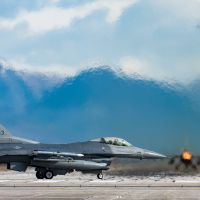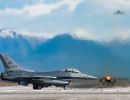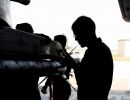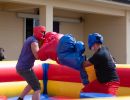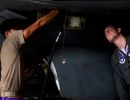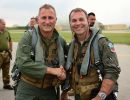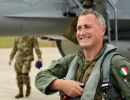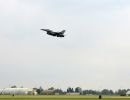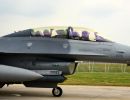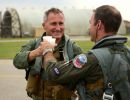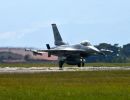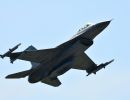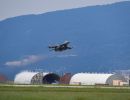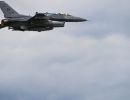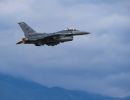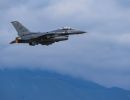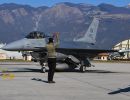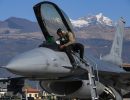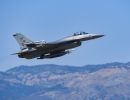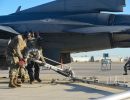Operation ALLIED FORCE
Ripley, Tim. Code One: Jul 1999. Vol. 14 No. 3: Pg 10-17.
 The 31st Air Expeditionary Wing at Aviano consists of two permanently based F-16 squadrons as well as deployed F-15Es, C-130s, KC-135s, F-117s, and F-16s from several other locations. The record total does not contain more than thirty US Navy and Marine Corps EA-6B squadrons and NATO aircraft from other countries, including British AWACS, Spanish and Canadian F-18s, and Portuguese F-16s. The influx of aircraft and people to fight the war has more than doubled the population at the base. Aircraft parking comes at a premium; every apron on the base is packed tightly.
The 31st Air Expeditionary Wing at Aviano consists of two permanently based F-16 squadrons as well as deployed F-15Es, C-130s, KC-135s, F-117s, and F-16s from several other locations. The record total does not contain more than thirty US Navy and Marine Corps EA-6B squadrons and NATO aircraft from other countries, including British AWACS, Spanish and Canadian F-18s, and Portuguese F-16s. The influx of aircraft and people to fight the war has more than doubled the population at the base. Aircraft parking comes at a premium; every apron on the base is packed tightly.

 Pilots of Aviano’s two F-16 squadrons, the 510th and 555th, have been at the forefront of the strike elements in the Yugoslavian bombing campaign since the first days. They have flown a variety of missions, including strike/interdiction, battlefield air interdiction, forward air control, close air support, combat air patrol, and defensive counter air. Pilots fly about five times a week in missions that average four to five hours. Early combat air patrol missions over Kosovo often lasted longer. As of 8 June, F-16s from Aviano had flown over 4,500 sorties and 21,000 hours in Allied Force missions, dropping and launching over 7,700 bombs, rockets, and missiles.
Pilots of Aviano’s two F-16 squadrons, the 510th and 555th, have been at the forefront of the strike elements in the Yugoslavian bombing campaign since the first days. They have flown a variety of missions, including strike/interdiction, battlefield air interdiction, forward air control, close air support, combat air patrol, and defensive counter air. Pilots fly about five times a week in missions that average four to five hours. Early combat air patrol missions over Kosovo often lasted longer. As of 8 June, F-16s from Aviano had flown over 4,500 sorties and 21,000 hours in Allied Force missions, dropping and launching over 7,700 bombs, rockets, and missiles.
The F-16s usually carry precision-guided munitions, mostly laser-guided bombs, though they occasionally employ general purpose bombs. On forward air control missions, they carry rocket pods with white phosphorous rockets to mark potential targets for aircraft flying close air support missions.
 Strike missions over Yugoslavia are supported by F-16s flying suppression of enemy air defense, or SEAD. Block 50 F-16s from the 52nd Fighter Wing at Spangdahlem Air Base in Germany were some of the first F-16s deployed to Aviano for this mission. These aircraft were supplemented with additional Block 50 F-16s from the 20th Fighter Wing at Shaw AFB in South Carolina, which arrived in Aviano on 16 April.
Strike missions over Yugoslavia are supported by F-16s flying suppression of enemy air defense, or SEAD. Block 50 F-16s from the 52nd Fighter Wing at Spangdahlem Air Base in Germany were some of the first F-16s deployed to Aviano for this mission. These aircraft were supplemented with additional Block 50 F-16s from the 20th Fighter Wing at Shaw AFB in South Carolina, which arrived in Aviano on 16 April.
SEAD aircraft are usually the first on the scene to provide force protection for subsequent strike packages. The Block 50 F-16s fly in both air-to-air and air-to-surface modes. Equipped with the AGM-88 High Speed Anti-Radiation Missile, these “Viper Weasels” have a unique capability to destroy enemy radar sites. The ultimate responsibility of the SEAD mission is to ensure that no allied aircraft is shot down by surface-to-air missiles. The Block 50 F-16s also carry HARM Targeting Systems, which provide sensor coverage over target areas for strike aircraft. They arrive early and build a picture before the strike aircraft get close so that the strikers can adjust routes accordingly.




A Block 50 F-16 pilot from Shaw’s 78th Fighter Squadron achieved the first USAF F-16 air-to-air kill of the Kosovo war when he shot down a Yugoslav MiG-29 near Belgrade on 4 May. The F-16 was one of four Block 50 aircraft heading for a tanker after a SEAD mission. The MiG-29 took off from Batajnica Air Base near Belgrade and was detected by a NATO E-3 AWACS. The F-16s were immediately vectored to engage the threat. Five minutes later, one of the F-16s locked onto the MiG and fired two AIM-120 Advanced Medium Range Air-to-Air Missiles. A few seconds later, the MiG exploded.
A USAF press release quoted the Shaw pilot, identified as “Dog,” after the flight: “We have the world’s finest multirole aircraft in this squadron, and we proved it,” he said. “We took off with a primary mission of suppressing ground and air-to-air threats, and we showed the flexibility and the training of US and allied pilots.”
 The F-16 pilot also stressed the team effort involved with every mission. “My flight members and crew chief, and the weapons and munitions folks, make sure I have equipment that works,” he said. “Frankly, if one of my fellow F-16 pilots hadn’t made the first call stating he’d heard the AWACS communications, I might not have turned around and gotten the successful engagement. Of course, the AWACS controller got me there, so it was a team effort from start to finish.”
The F-16 pilot also stressed the team effort involved with every mission. “My flight members and crew chief, and the weapons and munitions folks, make sure I have equipment that works,” he said. “Frankly, if one of my fellow F-16 pilots hadn’t made the first call stating he’d heard the AWACS communications, I might not have turned around and gotten the successful engagement. Of course, the AWACS controller got me there, so it was a team effort from start to finish.”
Army Gen. Wesley Clark, supreme allied commander Europe, described the MiG shoot down this way: “Yugoslavian President Slobodan Milosevic launched a MiG-29 in an effort to pursue one of our groups after we departed from a daylight operation over Serbia. We picked it up, we turned, and we shot it down.”
Tim Ripley is a military journalist based in England.
European F-16s In Allied Force
BY ERIC STIJGER
An F-16 from the Royal Netherlands Air Force locked onto a Yugoslav MiG-29, fired an AIM-120 AMRAAM, and downed the Fulcrum in the opening scenes of the NATO Operation Allied Force in March. The shoot down occurred when a four ship of F-16s were escorting a strike package of Tornadoes, F-15E Strike Eagles, and additional F-16s to Serbia from northern Kosovo. During the flight, these allied forces were notified by AWACS that three MiG-29 Fulcrums had taken off from an airbase near Belgrade. And one of the MiGs was heading in their direction.
The lead pair of F-16s picked up the Fulcrum first but chose not to engage it. Instead, they relayed their radar and target data to the second pair of F-16s. The lead F-16 of this second pair locked onto the low-flying Fulcrum and fired an AIM-120 AMRAAM. Thirty seconds later, the Fulcrum exploded into a ball of fire against the night sky and disappeared from the radar. The first MLU aerial victory, and, indeed, the first air-to-air victory of Operation Allied Force, was confirmed by the AWACS controller.
 Though the Dutch MLU F-16s were the first aircraft to enter Yugoslav airspace, their victory signifies a team effort. “Everybody is working hard to keep up with the mission tasks,” said Lt. Col. Jon Abma of the RNLAF and commander of the joint Dutch-Belgian F-16 detachment at Amendola Air Base early in the operation. “Because of the MLU F-16, we have led the operation from the beginning.” While non-MLU F-16s were tasked initially for daytime missions only, the MLU F-16s have been called for various missions around the clock from the start of the operation. The all-weather and beyond-visual-range missile capability of the Dutch MLU F-16s identified them for fighter escort sweep missions. Armed with the AGM-65G Maverick, they can perform emergency close air support on the same mission
Though the Dutch MLU F-16s were the first aircraft to enter Yugoslav airspace, their victory signifies a team effort. “Everybody is working hard to keep up with the mission tasks,” said Lt. Col. Jon Abma of the RNLAF and commander of the joint Dutch-Belgian F-16 detachment at Amendola Air Base early in the operation. “Because of the MLU F-16, we have led the operation from the beginning.” While non-MLU F-16s were tasked initially for daytime missions only, the MLU F-16s have been called for various missions around the clock from the start of the operation. The all-weather and beyond-visual-range missile capability of the Dutch MLU F-16s identified them for fighter escort sweep missions. Armed with the AGM-65G Maverick, they can perform emergency close air support on the same mission
The Dutch pilots got a head start on the F-16 MLU at Amendola where they and their maintenance crews team with colleagues of the Belgian Air Force, forming what is called a Deployable Air Task Force, or DATF. The joint detachment works under one single commander, placing personnel of one nation under the command of another nation. The DATF operates thirty-two F-16s.
Last January, the detachment relocated from Villafranca Air Base in northern Italy to Amendola near Foggia in southern Italy when Villafranca closed for runway repairs. In the same timeframe, MLU F-16s were delivered to the DATF on a permanent basis, making the RNLAF the first air force to introduce the fighter in an operational theater.
“Introducing the MLU F-16 into the DATF went smoothly,” recalls Abma. “We brought a few of these aircraft to Villafranca last November when tension was building in Kosovo. That move gave us the opportunity to experience the new systems and weapons in a deployed environment.” The F-16s were returned to Leeuwarden when tension subsided.
 In late March, the RNLAF began flying air-to-ground missions with both MLU and non-MLU F-16s. Soon after, the first three Belgian MLUs arrived. Although the pace quickened, the RNLAF rotated aircraft and personnel. Leeuwarden crews passed the candle to 315 Squadron from Twenthe Air Base. The 315 had just completed its conversion to the MLU just months prior to the deployment to Amendola. The next week, the command of the DATF was passed to Lt. Col. Frank DeWinne, the 1997 recipient of Lockheed Martin’s Dryden Semper Viper Award and the first Belgian officer to take command of the DATF. DeWinne plays down any significance to his command. “Given the transparency of the organization and the intensity of our mutual cooperation, who holds command makes little difference.”
In late March, the RNLAF began flying air-to-ground missions with both MLU and non-MLU F-16s. Soon after, the first three Belgian MLUs arrived. Although the pace quickened, the RNLAF rotated aircraft and personnel. Leeuwarden crews passed the candle to 315 Squadron from Twenthe Air Base. The 315 had just completed its conversion to the MLU just months prior to the deployment to Amendola. The next week, the command of the DATF was passed to Lt. Col. Frank DeWinne, the 1997 recipient of Lockheed Martin’s Dryden Semper Viper Award and the first Belgian officer to take command of the DATF. DeWinne plays down any significance to his command. “Given the transparency of the organization and the intensity of our mutual cooperation, who holds command makes little difference.”
In Belgium, DeWinne commands 349th Squadron at Kleine Brogel Air Base, Belgium’s first squadron to convert to the MLU F-16. The Belgium Air Force has aircraft and personnel from the 10th Tactical Wing at Kleine Brogel, which includes the 349th, the 23rd, and the 31st squadrons, augmented by personnel from the 1st Squadron at Florennes Air Base.
As the Yugoslav air threat diminished, the Combined Air Operations Center in Vicenza, Italy, concentrated more on ground attack missions for the DATF F-16s. About two-thirds of the sorties are now flown against ground targets, with almost one-third for combat air patrol and escort sweep missions. In late April, the RNLAF also began flying photo reconnaissance from Amendola with three F-16s from 306th Squadron at Volkel Air Base. By late May, the sorties generated by the 500-people-strong DATF surpassed 1,100 for the RNLAF and 600 for the BAF.
Allied Force attacks are being carried out against a wide range of targets, such as command and control sites, radio relay stations, oil refineries, bridges, ammunition depots, airfields, and fielded forces. In late April, a number of RNLAF F-16s carried out an attack against a Yugoslav air base near Podgorica in Montenegro, destroying eighteen aircraft and helicopters on the ground.
 The ground attack capabilities of DATF improved in April when the Dutch unit received its first three targeting pods. Shortly before, the RNLAF had received two LANTIRN targeting pods leased from USAF as a stopgap. To operate the targeting systems, the RNLAF dispatched its LANTIRN-qualified F-16 pilots to Amendola.
The ground attack capabilities of DATF improved in April when the Dutch unit received its first three targeting pods. Shortly before, the RNLAF had received two LANTIRN targeting pods leased from USAF as a stopgap. To operate the targeting systems, the RNLAF dispatched its LANTIRN-qualified F-16 pilots to Amendola.
DeWinne is very satisfied with the DATF’s targeting pods. “The capability has brought a new dimension to our operation,” he says. “We can now perform precision attacks around the clock. Adapting to this capability clearly shows the strength of the MLU.” The targeting pods allow the DATF to drop and steer laser-guided bombs like the 2,000-pound GBU-10 and 500-pound GBU-12. “The laser guided capability of the Dutch targeting pods has increased our interoperability,” DeWinne adds. “For instance, Belgian pilots are dropping GBUs on targets illuminated by their Dutch colleagues, day and night.” Those ground targets destroyed with laser-guided bombs included three Yugoslav MiG-29s.
Besides Belgium and the Netherlands, F-16s from Denmark and Norway are also participating in Allied Force from Grazzanise Air Base near Naples, where both nations have established detachments. Though under separate commanders, both nations are operating in close cooperation. Squadron 730 from Skrydstrup Air Base forms the core of the Danish detachment. The operations officer of the Skrydstrup wing, Lt. Col. Frits Rasmussen, leads the Danish contingent of about one hundred personnel. “Together with the Norwegians, we are tasked mainly with defensive counter air missions, flying daytime combat air patrol missions all over the area,” says Rasmussen.
 Like the DATF aircraft, the F-16s from both Denmark and Norway carry the AIM-120 as the principal weapon for air-to-air missions. “It’s an ideal weapon for the mission,” says Rasmussen, “even on a non-MLU aircraft.” The introduction of the MLU F-16 with the Danish detachment is a recent development—the first three MLU F-16s arrived on 11 May from Aalborg Air Base to augment the initial nine non-MLU F-16s. In contrast, the detachment operated by the Royal Norwegian Air Force is still fully equipped with non-MLU F-16 aircraft.
Like the DATF aircraft, the F-16s from both Denmark and Norway carry the AIM-120 as the principal weapon for air-to-air missions. “It’s an ideal weapon for the mission,” says Rasmussen, “even on a non-MLU aircraft.” The introduction of the MLU F-16 with the Danish detachment is a recent development—the first three MLU F-16s arrived on 11 May from Aalborg Air Base to augment the initial nine non-MLU F-16s. In contrast, the detachment operated by the Royal Norwegian Air Force is still fully equipped with non-MLU F-16 aircraft.
“We are not planning to bring our MLUs here,” explains Col. Finn Hannestad, who leads the Norwegian detachment. As the operations group commander at Bodo Air Base in Norway, Hannestad is in charge of a detachment of aircraft and personnel from all RNoAF F-16 units. “The 332nd Squadron has no jets here because they have converted to MLU aircraft,” he says. Of all European F-16 operating nations, the Norwegian detachment is the most recent participant in the Balkan mission. Norway’s six-aircraft detachment arrived in Italy on 22 January this year with around 140 personnel. As with the Danish, defensive counter air is the primary mission for the Norwegians.
 The Portuguese Air Force has also been supporting Allied Force with three F-16s and sixty personnel at Aviano. The Portuguese detachment, the 201st Squadron at Monte Real Air Base, is housed with the 555th Fighter Squadron—one of Aviano’s two permanent USAFE F-16 units. According to the squadron’s commander, Maj. Mario Barreto, “We consider ourselves very lucky to be here. We are operating out of the busiest air base of the entire operation, which enables us to learn a lot.” Like the Danish and Norwegians, the Portuguese
The Portuguese Air Force has also been supporting Allied Force with three F-16s and sixty personnel at Aviano. The Portuguese detachment, the 201st Squadron at Monte Real Air Base, is housed with the 555th Fighter Squadron—one of Aviano’s two permanent USAFE F-16 units. According to the squadron’s commander, Maj. Mario Barreto, “We consider ourselves very lucky to be here. We are operating out of the busiest air base of the entire operation, which enables us to learn a lot.” Like the Danish and Norwegians, the Portuguese
F-16s perform combat air patrol but have to rely on the AIM-9 Sidewinder missiles only. “We are hoping to receive AMRAAMs a little bit quicker now,” Barreto adds, highlighting the relevance of a beyond visual range missile capability.
F-16s of the Turkish Air Force are also participating in Allied Force operations. Turkish forces, based at Ghedi Air Base in Italy for several years, have been supporting Deny Flight operations over Bosnia. Turkish pilots have accumulated over 30,000 hours in these operations alone. For Allied Force, the TuAF has increased its F-16 force at Ghedi by six aircraft.
Operation Allied Force demonstrates the strength and flexibility of the F-16. They fly in before strike packages to suppress or destroy surface-to-air missile threats. They are often an integral part of those strike packages. And they fly combat air patrols to protect those strikers from threat aircraft. “This aircraft provides so many capabilities,” says Lt. Col. Abma, “and this operation is testing them all.”

Eric Stijger is an aviation writer and photographer based in the Netherlands.

 Almost 200 F-16s from seven nations have so far been committed to Operation Allied Force since the attacks on Kosovo and Serbia began on 24 March. F-16s allocated to the operation are flying from eight bases in three countries. The largest contingent of F-16s, about seventy, can be found at Aviano Air Base in northern Italy. In fact, Allied Force has made Aviano home to the largest single Air Force combat wing ever assembled at one base.
Almost 200 F-16s from seven nations have so far been committed to Operation Allied Force since the attacks on Kosovo and Serbia began on 24 March. F-16s allocated to the operation are flying from eight bases in three countries. The largest contingent of F-16s, about seventy, can be found at Aviano Air Base in northern Italy. In fact, Allied Force has made Aviano home to the largest single Air Force combat wing ever assembled at one base. 
